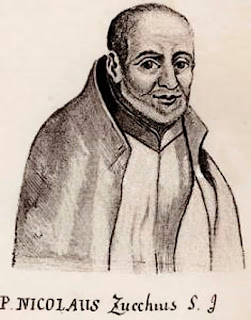Jesuit's invention gave him a clear view of the planets
 |
| A rare portrait of Niccolò Zucchi |
Niccolò Zucchi, who designed one of the earliest reflecting telescopes, was born on this day in 1586 in Parma.
His invention enabled him to be the first to discover the belts on the planet Jupiter and to examine the spots on the planet Mars. This was before the telescopes designed by James Gregory and Sir Isaac Newton, which, it has been claimed, were inspired by Zucchi’s book, Optica philosophia.
Zucchi studied rhetoric in Piacenza and philosophy and theology in Parma before entering the Jesuit order in Padua at the age of 16.
He taught mathematics, rhetoric and theology at the Collegio Romano in Rome and was then appointed rector of a new Jesuit college in Ravenna. He then served as apostolic preacher (the preacher to the Papal household) for about seven years.
 |
| A modern image of Jupiter from the Hubble telescope shows the belts Zucchi reputedly saw in 1630 |
Zucchi published several books about mechanics, magnetism, barometers and astronomy.
When he was sent with other papal officials to the court of Ferdinand II, he met the German mathematician and astronomer, Johannes Kepler, who encouraged his interest in studying the planets. They carried on writing to each other after Zucchi returned to Rome and when Kepler got into financial difficulties, Zucchi gave him one of his own telescopes as a gift.
Along with a fellow Jesuit, Daniello Bartoli, Zucchi was probably the first to see the belts on the planet Jupiter in 1630 and he reported seeing spots on Mars in 1640.
He also demonstrated that phosphors generate light, rather than store it, in 1652.
 |
| The lunar crater Zucchius is named after Niccolò Zucchi |
Although many people have written that Zucchi used his early reflecting telescope to observe the planets, this was disputed by some historians in the 19th century. However, the crater Zucchius on the Moon was named after him, in acknowledgement of his scientific achievements.
Zucchi died in Rome in 1670, at the age of 83.
Travel tip:
Parma, where Niccolò Zucchi was born, is one of Italy’s great art cities and has a wealth of churches and palaces containing masterpieces. The ancient city in the region of Emilia-Romagna is also famous for its culinary specialities. Parmigiano-Reggiano cheese and Prosciutto di Parma, a delicate cured ham, originated there, as well as the many dishes cooked alla parmigiana.
 |
| The Collegio Romano, where Zucchi taught |
Travel tip:
The Collegio Romano, where Niccolò Zucchi taught in Rome, was established in 1551 by Ignatius Loyola, the founder of the Jesuit Order. A new building was erected for the College, under the patronage of Pope Gregory XIII, in 1582. The building where Zucchi gave his lectures is in the Pigna district of the city in a square now known as Piazza del Collegio Romano. The building is currently used partly by the Ministry of Heritage and Culture and partly by the Ennio Quirino Visconti high school.
